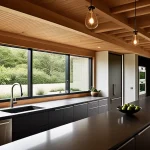Effects of Sustainable Décor on Home Atmosphere
Sustainable home design significantly enhances indoor environments by integrating eco-friendly décor that utilizes natural materials like bamboo, cork, and reclaimed wood. These materials not only reduce the carbon footprint but also contribute to better indoor air quality by limiting harmful chemical emissions from synthetic alternatives. Incorporating sustainable practices such as using low-VOC paints and energy-efficient appliances fosters a healthier and cleaner home atmosphere.
The benefits of green living extend beyond physical health, positively impacting mental well-being. Research shows that exposure to natural elements in the home can reduce stress and promote relaxation, making the living space more inviting and calming. For instance, homes dressed in warm, natural textures and hues create a serene ambiance that supports emotional comfort.
In parallel : What Are the Current Trends in UK Home Living Preferences?
Real-world transformations highlight how eco-friendly décor can shift a home’s ambiance from sterile to vibrant. One such example involves replacing plastic furnishings with handcrafted items made from sustainable materials, instantly enhancing warmth and character throughout the space. These green choices foster a deep connection to nature and encourage mindful living, reinforcing the overall benefits of embracing sustainability indoors.
Practical Elements of Eco-Friendly Décor
Choosing the right eco-friendly materials is central to creating a truly sustainable home. Opting for furnishings made from natural fibers, reclaimed wood, or recycled metals reduces environmental impact while avoiding toxic chemicals often found in synthetic options. These materials are durable and often biodegradable, aligning with the principles of green living.
This might interest you : How Can Sustainable Design Transform Your Home’s Aesthetics?
Pairing these materials with sustainable colors further enhances the eco-conscious atmosphere. Earth-inspired palettes, such as soft greens, warm beiges, and muted browns, promote calmness and seamlessly blend with natural décor elements. These colors are typically applied using low-VOC or non-toxic paints, contributing to healthier indoor air quality.
Green lighting plays a vital role by combining functionality with sustainability. Incorporating energy-efficient LED bulbs and maximizing natural daylight reduces energy consumption and creates inviting, warm spaces. Strategic placement of windows, skylights, or light tubes can flood rooms with natural light, elevating mood and reducing the dependence on artificial lighting.
The addition of houseplants is both practical and aesthetic. Indoor plants improve air quality by filtering pollutants and increasing oxygen levels. Beyond purification, they add visual softness and a sense of connection to nature, enhancing the overall benefits of green living. Popular choices like snake plants, pothos, and peace lilies are low-maintenance yet effective for indoor air improvement.
Together, these elements illustrate how thoughtful choices in materials, colors, lighting, and greenery cohesively build an eco-friendly home environment that supports health, sustainability, and comfort.
Health and Wellness Benefits of Eco-Conscious Décor
Creating a healthy home with eco-conscious décor deeply influences indoor air quality, which is critical for overall wellness. Natural and non-toxic materials release fewer pollutants, reducing allergens and airborne irritants that can exacerbate respiratory issues. This improvement in air quality directly supports better breathing and overall physical health, making eco-friendly décor a practical choice for enhancing home wellness.
Beyond physical health, the wellness benefits of green living extend into emotional and mental well-being. Mindful interiors that emphasize simplicity and natural elements help reduce stress and foster calmness. By minimizing clutter and using calming, nature-inspired décor, residents experience improved relaxation and emotional comfort, reinforcing the connection between environment and mental health.
Implementing eco-conscious décor also encourages a lifestyle focused on balance and mindfulness. Thoughtful selection of furnishings and décor not only promotes environmental responsibility but also invites intentional living. This careful curation of space creates homes that are both beautiful and nurturing, supporting holistic wellness through sustainable choices.
Health and Wellness Benefits of Eco-Conscious Décor
Creating a healthy home through eco-conscious décor profoundly influences indoor air quality, yielding significant wellness benefits. Eco-friendly materials and low-emission finishes reduce the presence of volatile organic compounds (VOCs) and other allergens, which improves breathing comfort and reduces respiratory irritations. This enhancement in air purity supports overall physical health by minimizing exposure to harmful pollutants often present in conventional home products.
Beyond physical health, the psychological benefits of mindful interiors are substantial. Spaces designed with sustainability in mind tend to foster stress reduction and emotional comfort. Natural textures, clutter-free layouts, and calming color schemes contribute to a tranquil environment that supports mental clarity and relaxation. Mindful interiors encourage intentional living, helping inhabitants disconnect from daily stressors and connect with their surroundings in a more meaningful way.
Integrating eco-friendly décor also leads to a more organized and purposeful space. Reducing excess and choosing multi-functional, sustainable furnishings create a sense of balance and order, enhancing both comfort and well-being. This practice aligns with the holistic nature of green living, where emotional, mental, and physical health are nurtured simultaneously through intentional design choices.
Implementing Eco-Friendly Décor in Your Home
Adopting practical eco-friendly décor begins with simple, thoughtful changes aligned with your home’s style and needs. To transition smoothly to a sustainable interior design, start by evaluating existing furnishings and focusing on durable, non-toxic items made from eco-friendly materials like reclaimed wood, organic fabrics, or recycled metals. These choices reduce environmental impact while enhancing the home’s character.
Sourcing sustainable décor items responsibly involves supporting local artisans or brands committed to ethical production and minimal carbon footprints. Prioritizing quality over quantity ensures longevity, reducing waste. Look for certifications or transparent supply chains to verify eco-conscious practices, helping you make informed decisions.
Incorporate green choices gradually by:
- Replacing synthetic rugs or cushions with those made from natural fibers such as jute or organic cotton.
- Introducing energy-efficient fixtures and maximizing natural light to complement your green lighting strategy.
- Adding houseplants known for air purification, like spider plants or peace lilies, to boost vitality and ambiance.
This measured approach encourages mindful living and reduces the overwhelm often associated with redecorating. By intertwining sustainable choices with your personal aesthetics, you create a healthful, balanced environment that reflects the benefits of green living while supporting environmental stewardship.






